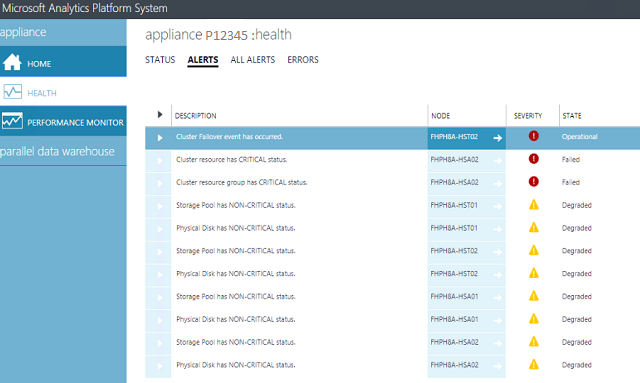Track appliance alerts in Analytics Platform System
This article explains how to use the Admin Console and system views to track alerts in a SQL Server PDW appliance.
Track appliance alerts
SQL Server PDW creates alerts for hardware and software issues that need attention. Each alert contains a title and a description of the issue.
SQL Server PDW logs alerts in the sys.dm_pdw_component_health_alerts DMV. The system retains a limit of 10,000 alerts and deletes the oldest alert first when the limit is exceeded.
View Alerts by using the Admin Console
There is an Alerts tab for the PDW region and for the fabric region of the appliance. After failover occurs, the failover event is included in the number of alerts on the page. There is a page for the PDW region and for the fabric region of the appliance. Each Health page has a tab. To learn more about an alert, select the Health page, the Alerts tab, and then select an alert.

On the Alerts page:
To view the alert history, select on the Review Alert History link.
To view the alert component and its current property values, select on the alert row.
To view details about the node that raised the alert, select on the node name.
View Alerts by Using the System Views
To view alerts by using system views, query sys.dm_pdw_component_health_active_alerts. This DMV shows alerts that have not been corrected. For help with triaging alerts and errors, use the sys.dm_pdw_errors DMV.
The following example is a common query for viewing the current alerts.
SELECT
aa.[pdw_node_id],
n.[name] AS [node_name],
g.[group_name] ,
c.[component_name] ,
aa.[component_instance_id] ,
a.[alert_name] ,
a.[state] ,
a.[severity] ,
aa.[current_value] ,
aa.[previous_value] ,
aa.[create_time] ,
a.[description]
FROM [sys].[dm_pdw_component_health_active_alerts] AS aa
INNER JOIN sys.dm_pdw_nodes AS n
ON aa.[pdw_node_id] = n.[pdw_node_id]
INNER JOIN [sys].[pdw_health_components] AS c
ON aa.[component_id] = c.[component_id]
INNER JOIN [sys].[pdw_health_component_groups] AS g
ON c.[group_id] = g.[group_id]
INNER JOIN [sys].[pdw_health_alerts] AS a
ON aa.[alert_id] = a.[alert_id] and aa.[component_id] = c.[component_id]
ORDER BY
a.alert_id ,
aa.[pdw_node_id];
Related content
Geri Bildirim
Çok yakında: 2024 boyunca, içerik için geri bildirim mekanizması olarak GitHub Sorunları’nı kullanımdan kaldıracak ve yeni bir geri bildirim sistemiyle değiştireceğiz. Daha fazla bilgi için bkz. https://aka.ms/ContentUserFeedback.
Gönderin ve geri bildirimi görüntüleyin